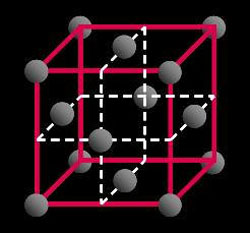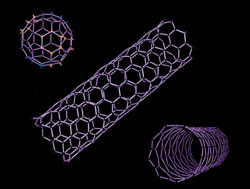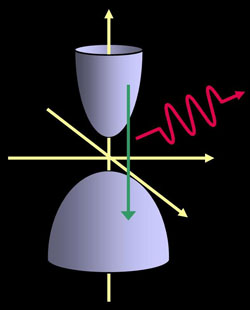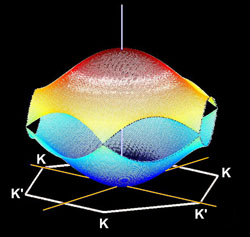ECE 4070 Contents
Syllabus and Course Details
Lecture Notes and Handouts
Homework and Exams
Note: Projects and Labs are not available for this course.
Lecture Notes and Handouts
- Handout 1 [PDF]: Drude model for metals, DC and high frequency conductivity of electrons in metals, Drude expression for dielectric constant of metals, plasma frequency, plasma oscillations with and without electron scattering.
- Handout 2 [PDF]: Sommerfeld model for electrons in metals, free Fermion gas, density of states in k-space and in energy, Fermi energy and Fermi surface, electron statistics, current flow under uniform electric field, conductivity of a free Fermion gas.
- Handout 3 [PDF]: Electrons in low dimensional metals, 1D and 2D free Fermi gases, density of states in k-space and in energy, Fermi energy, Fermi circle and Fermi point, electron statistics, current flow under uniform electric field, conductivity of Fermion gases in 1D and 2D.
- Handout 4 [PDF]: Crystal lattices in 1D, 2D, and 3D, Bravais lattices, primitive cells and unit cells, Wigner-Seitz cell, primitive lattice vectors, lattice with a basis, lattices of important metals and semiconductors in 3D and 2D.
- Handout 5 [PDF]: Fourier transforms of lattices, reciprocal lattice in 1D, 2D, and 3D, reciprocal lattice vectors, Brillouin zones, Fourier transforms of lattice periodic functions, lattice planes, X-ray diffraction, Bragg condition and Bragg planes.
- Handout 6 [PDF]: Electrons in a periodic potential, Bloch’s theorem and Bloch functions, electron Bragg scattering, nearly free electron approach and perturbation theory, finite basis expansion, physical origin of bandgaps, location of bandgaps, zone folding, introduction to energy bands in solids.
- Handout 7 [PDF]: Properties of Bloch functions, periodic boundary conditions, density of states in k-space, number of states per band, band filling, Fermi contours (2D) and Fermi surfaces (3D) in energy bands, energy bands and band filling in semiconductors.
- Handout 8 [PDF]: Energy levels in atoms and molecules, covalent bonding in molecules, introduction to LCAO (linear combination of atomic orbitals), energy level splitting in molecules, finite basis expansions, sp3 and sp2 hybridizations, sigma and pi bonds, and examples.
- Handout 9 [PDF]: MOS field effect transistors (FETs), regimes of operation; cut-off, linear (triode), and saturation, MOS current vs voltage relations, backgate effect, velocity saturation effects, and breakdown.
- Handout 10 [PDF]: Tight binding method applied to lattices with more than one atom in the primitive cell, examples in 1D and 2D, pi-energy bands in conjugated hydrocarbons, energy bands in polyacetylene, energy bands of Germanium.
- Handout 11 [PDF]: Crystal structure and energy bands in graphene, tight-binding approach and comparison with the nearly-free-electron approach.
- Handout 12 [PDF]: Computation of energy bands in group IV (Silicon, Germanium, and Diamond) and group III-V (GaAs, InP) semiconductors with cubic symmetry using tight binding method, Bloch functions at the G-point, improved techniques for the calculation of energy bands in semiconductors.
- Handout 13 [PDF]: Biasing and loading single stage FET amplifiers, active loads and active biasing schemes, cascode loads.
- Advance Topic Handout (Symmetries) [PDF]: Symmetries, electronic bands, and electronic states; relationship between crystal symmetries and energy bands in solids in the absence and in the presence of spin-orbit coupling effects.
- Handout 14 [PDF]: Electron statistics in energy bands, effective density of states and effective density of states mass, isotropic and anisotropic effective mass tensors, introduction to holes, electron and hole pockets, case of silicon, germanium, and gallium arsenide.
- Handout 15 [PDF]: Dynamics of electrons in energy bands, the dynamical equation for the crystal momentum in the presence of external fields, applicability of Ehrenfest’s theorem to electrons in energy bands, effective mass tensor and inertia of electrons, acceleration of electrons.
- Handout 16 [PDF]: Inversion symmetry of energy bands, current density in energy bands, electron-hole transformation, conductivity of electrons in conduction bands and holes in valence bands, conductivity tensor of semiconductors, conductivity effective mass, Bloch oscillations.
- Advance Topic Handout (Berry’s Phase) [PDF]: Guage invariance and electron dynamics in solids, Berry’s phase correction to electron dynamics, Berry’s curvature.
- Handout 17 [PDF]: Lattice vibrations and phonons in 1D, phonons in 1D crystals with monoatomic basis, phonon in 1D crystals with diatomic basis, force constants and the dynamical matrix, optical and acoustic phonons, phonon phase and group velocities, phonon dispersion and eigenvectors.
- Handout 18 [PDF]: Phonons in 2D with monoatomic and diatomic basis, force constants and dynamical matrices, longitudinal acoustic and transverse acoustic phonon modes, longitudinal optical and transverse optical phonon modes, phonon dispersion and eigenvectors.
- Handout 19 [PDF]: Phonons in 3D with monoatomic and diatomic basis, phonons bands in group IV and group III-V semiconductors, macroscopic models of acoustic phonons in solids, stress and strain tensors, Hooke’s law, phonons in cubic semiconductors.
- Handout 20 [PDF]: Quantum mechanical description of lattice waves in solids, commutation relations and quantization of lattice waves, phonons, energy of phonons.
- Handout 21 [PDF]: Phonon statistics, Bose-Einstein distribution, phonon density of states in 1D, 2D and 3D, Debye and Einstein models, thermal energy, heat capacity of solids.
- Handout 22 [PDF]: Non-equilibrium distribution functions, Liouville equation, Boltzmann equation, relaxation time approximation, conductivity, scattering beyond the relaxation time approximation.
- Handout 23 [PDF]: Position dependent non-equilibrium distribution functions, Boltzmann equation, local equilibrium distribution, transport equations, transport via drift and diffusion, Einstein relations.
- Handout 24 [PDF]: Electron states in crystals with external perturbations, the effective mass theorem and the effective mass Schrodinger equation, envelope function, donor and acceptor impurities in semiconductors, donor and acceptor energy levels and states (defect states in crystals), donor and acceptor statistics.
- Handout 25 [PDF]: Semiconductor heterostructures and heterojunctions, band diagrams in real space, electron affinity and work function, heterojunctions in equilibrium, band alignment and band offsets.
- Handout 26 [PDF]: Electrons in quantum confined 2D nanostructures, semiconductor quantum wells, effective mass equation, energy quantization, reduced density of states, and device applications.
- Handout 27 [PDF]: Electrons in quantum confined 1D and 0D nanostructures, semiconductor quantum wires and dots, effective mass equation, energy quantization, reduced density of states, and device applications.
- Handout 28 [PDF]: Ballistic electron transport, ballistic electron transport in quantum wires, conductance and resistance quantization, quantum of conductance, scattering and transmission, conductance as transmission, Landauer’s formula.
- Handout 29 [PDF]: Optical transitions in solids, Fermi’s golden rule, electron-photon Hamiltonian, intraband and interband optical transitions, optical matrix elements, crystal momentum selection rule, transition rates, loss coefficients of semiconductors, stimulated absorption and stimulated emission of photons, population inversion and optical gain, semiconductor heterostructure lasers.
- Handout 30 [PDF]: Optical processes and the dielectric constant of solids, linear response functions and Kramers-Kronig relations, interband and intraband contributions to the dielectric constant of solids, dielectric constant of conductive solids and the plasma frequency.
- Advance Topic Handout (Polaritons) [PDF]: Polaritons, longitudinal and transverse polaritons, phonon-polaritons and plasmon polaritons.
- Handout 31 [PDF]: Electron states and energy bands in carbon nanotubes, zigzag and armchair nanotubes, semiconductor and metallic behavior of nanotubes, device applications.
- Handout 32 [PDF]: Transport of thermal energy by electrons, thermoelectric effects, Seebeck effect and thermopower, Peltier effect, thermoelectric cooling, thermoelectric energy conversion.



